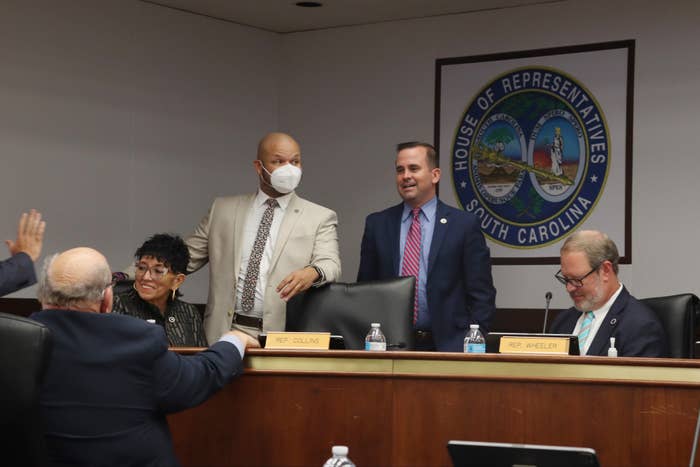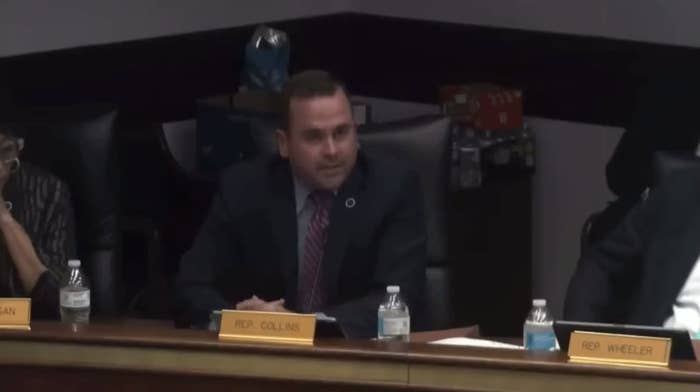
Millions of girls and women in the US — about 1 in 3 — have lost their constitutional right to abortion since the overturn of Roe v. Wade, the 1973 decision that granted pregnancy-capable people autonomy over their reproductive health.
Now, two months later, at least one politician in South Carolina, which bans abortion once a fetal heartbeat is detected around six weeks, is beginning to realize the dangerous and potentially deadly consequences of his decision that medically knowledgeable people saw coming.
During an Aug. 17 meeting to discuss a near-total abortion ban in the state, Republican Rep. Neal Collins said a doctor called just two weeks after South Carolina’s “fetal heartbeat” law went into effect to inform him about a pregnant 19-year-old experiencing a miscarriage at 15 weeks. (A video of the meeting posted on Twitter has been viewed more than 3.4 million times.)
The woman had two options: have the fetus surgically removed or go home and hope that it would naturally be expelled from the uterus. The latter choice, doctors say, is particularly dangerous to pursue during the second trimester because it increases the pregnant person’s risks of hemorrhaging, developing a full body infection called sepsis, and death.
Yet, the law made it clear. The woman was discharged home because the fetus still had a heartbeat.
“The doctor told me she's going to pass this fetus in the toilet. She's going to have to deal with that on her own,” Collins said in the meeting as he held back tears. “There's a greater than 50% chance that she's going to lose her uterus. There's a 10% chance that she will develop sepsis and herself die.”
The GOP lawmaker said the woman, about three weeks later, returned to the emergency department to have the fetus removed. It had died inside her and remained inside her body, which can happen with any miscarriage or fetal death.
“That weighs on me. I voted for that [fetal heartbeat] bill. These are affecting people,” Collins said. “That whole week I did not sleep. … What we do matters.”

As a result, Collins and four other legislators, including two other Republicans, did not vote on the new bill that would outlaw nearly all abortions, with some exceptions to protect the life of the parent but none for pregnancies caused by rape or incest. Still, it advanced to the state House floor with a 13–7 vote.
Besides the realization that pregnancy-capable folks are people, too, (who would’ve known!) the GOP lawmaker’s remarks are a reminder that pregnancy is dangerous, including nonviable ones that end in miscarriages and fetal deaths, and that anti-abortion laws can force pregnant people, even those who want their pregnancy, into painful, deadly, and potentially criminalizing situations.
“Doctors have always known that you can't separate out good pregnancies and bad ones; that you can't separate out people who deserve care and people who don't; that pregnancy is a spectrum,” said Dr. Katharine White, vice chair of academics in the Boston Medical Center’s OB-GYN department. “Whenever you put in place a broad ban on one type of care, the ripple effects affect people having all kinds of pregnancy complications.”
“Doctors were fearing this from the beginning,” White said, “and now our fears are coming true.”
Why nonviable pregnancies are so dangerous, especially when denied the appropriate medical care
Nonviable pregnancies are those that will always end in a loss, meaning a healthy fetus cannot be carried to term. These are known as miscarriages (technically called a spontaneous abortion), missed abortion (a miscarriage in which the fetus is not expelled from the uterus), ectopic pregnancy (the embryo implants outside the uterus, which is a life-threatening medical emergency), stillbirth, or fetal death.
Pregnancy loss, and the medical care needed to manage it, is generally determined by when it occurs. Most cases happen earlier on, with about 80% of pregnancy losses occurring in the first trimester. And oftentimes, the cause is unknown. About 50% of the majority of cases with known causes are due to fetal genetic abnormalities.
We do know, however, that the health risks of nonviable pregnancies increase the longer care is withheld, said White, who wrote the book Your Guide to Miscarriage and Pregnancy Loss.
If a person is diagnosed with a miscarriage during their first trimester, they often have three choices: wait until they pass the fetus on their own, surgically remove the fetus in a procedure called dilation and curettage, or take medications such as misoprostol and mifepristone.
Waiting to pass the fetus naturally is problematic, White said, because there’s no way to tell when, or if, it’s going to happen. In fact, White advises her patients that it tends to happen in the most inconvenient times, like while driving or working, when bathroom access is limited.
Miscarriage-related bleeding can be “extremely heavy,” she said, and the longer it happens the higher the risk of developing an infection in the uterus that will affect a person’s fertility later on. This infection can spread to the entire body and damage other organs if not addressed with the appropriate medical care. This is known as sepsis, which was the second leading cause of pregnancy-related deaths in the US between 2016 and 2018.
Although rare, most deaths (about two-thirds) from pregnancy are preventable. Still, about 700 women die in the US each year from pregnancy-related complications. It's worth noting that homicide was a leading cause of death during and after pregnancy in the US from 2018 to 2019.
What’s more, a person could be hemorrhaging or septic, and the fetus could still have a heartbeat.
(The US actually has one of the worst maternal mortality rates compared with other wealthy nations — and it keeps getting worse. In 2020, the rate stood at 23.8 deaths per 100,000 live births compared with a rate of 20.1 the year prior, according to the CDC. The maternal mortality rate for Black women was 2.9 times that of white women. Risks generally increase with age.)
Waiting to pass the fetus also increases the likelihood someone needs emergency care, “which is never as good as planned care in terms of risks” because of the procedures and medications involved, White said.
Those who’d rather have surgery or take medications to manage their miscarriage run into different problems. These same procedures and drugs are also used to induce abortion, so many doctors are hesitant or simply cannot perform or administer these options for fear of criminalization in states with strict abortion laws.
“When you have a nonviable pregnancy, there is no medical benefit of delaying treatment. You want to treat the pregnant person. You want their health to be the number one thing that you're focused on,” White said. “But these bans are getting in the way of that.”
Once someone with a nonviable pregnancy enters their second trimester, the game changes: waiting to pass the fetus — the only alternative for many people in states with anti-abortion laws in place — is no longer an option “because the risks are too great,” White said. Surgery is the only safe route in this instance.
“Take all the risks of the first trimester and magnify the severity of them,” she said of second-trimester complications.
Ectopic pregnancy is another potential problem that’s not always protected under certain abortion laws. If an embryo forms in the fallopian tube, for example, its growth may cause the tube to burst, causing severe bleeding and shock.
Molar pregnancies (when an egg and sperm morph into a noncancerous tumor in the uterus instead of a fetus) and blighted ova (when an embryo never develops or it stops developing) are other common types of nonviable pregnancies that can lead to serious health consequences if left untreated in the appropriate time frame.
Only if a doctor deems a pregnancy an immediate danger to the pregnant person's life — and if the state permits exceptions for parental health — can the necessary care take place. But those decisions aren’t always easy to make because no clearly defined threshold exists that determines when someone is about to die, White said.
Doctors could also be questioned and even criminalized for making these judgment calls that another unqualified person doesn’t agree with.
“People could bleed for days or weeks and it's still not quite at the level of danger where [a doctor] feels comfortable intervening,” White said.
The effects of anti-abortion laws can have detrimental impacts on mental health, too. Even healthy, viable pregnancies are difficult. The CDC says 1 in 8 women experience postpartum depression, and that the rate of depression diagnoses at delivery is increasing.
It’s even more mentally taxing for people who experience pregnancy loss and in some cases are then forced to carry these fetuses to term, White said. “Now instead of being able to end this pregnancy, grieve, heal, and then try again, they're sitting with the fact that they have a pregnancy inside of them that will not result in a baby that they definitely want — and no one will treat them,” she said.
“It’s not possible to create bans that only affect the people whose decisions you don't agree with,” White said. “Bans on medical care can affect anyone who is pregnant, including people who are really happy about that pregnancy.”
